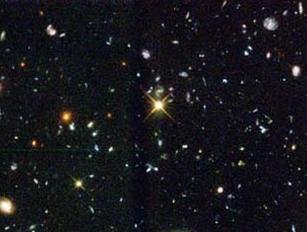When I was a kid, the age of the earth had been pegged pretty accurately at around four billion years--quite a difference from the Biblical estimates of four thousand (only a small fraction of human history). The rest of the universe was thought to be somewhat older, but perhaps not more than double that figure, or around eight billion years. Gradually, astronomers refined the figure upward till it exceeded ten billion. But the aging process didn't stop there. Current estimates range from eleven to as high as twenty billion years. (To get some idea of how the calculations are done, check this out, or Google the age of the universe.) The estimates vary so widely because there is still so much we don't know, such as how much "dark" matter and energy is out there--the existence of which was only recently discovered.
Normally most of us don't think about all this very much, except while watching an episode of Nova on PBS. But the other day something brought it all home to me in a new way. It was reported that astronomers had detected the explosion of a star twelve billion light-years distant--meaning, of course, that the explosion happened twelve billion years in the past, and the news of the event, traveling at the speed of light, has only now arrived.
It's one thing to consider millions of galaxies being that far away, but there was something peculiarly nostalgic and evocative about one particular individual star being singled out over such a huge distance. I felt as if a window to the past had suddenly opened, leaving me gazing across this vast stretch of space and time the way Gatsby stared across his lake at the dim beacon that marked the home of his lost and unattainable love.
So, twelve billion years ... the place is at least that old--older, because the star had already formed and burned for at least some millions of years before it blew up. And it is at least that large in all directions from here. Does that mean it's twice twelve billion? Or even larger/older? Or is that just a trick of perspective, due to space itself being curved?
Maybe, in the fullness of time, we will have lifted our heads high enough to see beyond the cosmic horizon, and know the answer. Until then, let this lonely beacon be a sign to us of all we have learned, and all we have yet to learn.










No comments:
Post a Comment